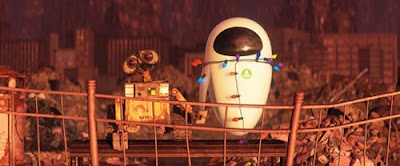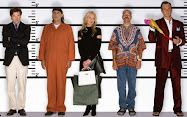
Technically, this isn't a review. There are enough reviews of WALL-E out there, and by now, I imagine that everyone has already seen it and developed opinions of their own. I decided to wait a week after first seeing it (that's right, I went opening day) because I wanted to let the imagery and philosophy really sink in, and I will not address the whole "it's pushing a liberal political agenda on children" because, really, why is caring for your planet a political thing? It's about survival and even Republicans want to survive. Right, but I'm not going to go into that... The following are aspects of WALL-E that floored me.

Visual Parallels: The Two Worlds
Although the allusions to commercialism and capitalism were blatant (BNL is the only corporation, come on), WALL-E subtly mirrored our future world on our present world. I've heard people gripe that the items WALL-E collects are all from the 20th century, but I think that was intentional. I don't think the Pixar crew just decided "let's choose things the audience is familiar with." I think the creative team made a conscious decision to make the statement, "In the future, there are these billboards and advertisements, and humans only care about commercial objects. But that's not so different from now." We look at the Rubik's Cube as something of the past, a toy, and everyone wanted one. Can you name one household that doesn't have in their possession a Rubik's Cube? It is an object that we own, but the product really owns us. And WALL-E's home is literally made up of his collection of objects. Sure, for WALL-E it's about curiosity and not monetary value, but we are not robots and we have walls comprised of toys and gadgets and other products. WALL-E's "junkyard" mirrors the futuristic world, where he is surrounded by commercialism. It reminded me a bit of John Carpenter's They Live!, where ideology is no longer subconscious but an outright "directive." In both worlds, he is surrounded by objects and ownership. In both worlds, people are defined by what they own.

The Hello, Dolly! References
Before I saw the movie, I snickered at reviews mentioning WALL-E's adoration for the dated musical Hello, Dolly!, but once the movie opened with the song "Put On Your Sunday Clothes," it was no longer funny. It was magical and beautiful. The basic concept of manifest destiny took on matters of space (as opposed to simple, physical, earthly land) as well as ambitions in love.
Put on your Sunday clothes, there's lots of world out there.For those of you that saw the movie and still snickered at references to the musical, the film is not silly for the musical it chose. Both share similar story-lines. Hello, Dolly! is about a matchmaker (made famous by Barbara Streisand) who inadvertently falls in love with the man she's try to match up. There is also a pair of males, Cornelius and Barnaby (the greatest names ever), who aspire to rise in social class and find love. WALL-E has a bit of both characters in him, representing both his amorous and adventurous sides. Cornelius and Barnaby make a pact (in the song "Sunday Clothes" no less) not to come back to Yonkers until they've kissed a girl. And, throughout WALL-E, our little mechanical hero never leaves EVE's side. He courts her. She doesn't immediately fall in love with WALL-E, who is literally of a lower status. And he does not leave her until he gets to hold her hand -- the robot equivalent to kissing, I suppose. I wouldn't necessarily say that Hello, Dolly! inspired WALL-E or that they perfectly mirror each other, but like all classic story lines, there are enough parallels to make it critically interesting. And to make your heart melt a little when WALL-E spins around his cabin, dancing with a top hat.
Put on your silk cravat and patent shoes.
We're gonna find adventure in the evening air.
-- from "Sunday Clothes"

Of course... the 2001 References
And, boy, were there a lot of them! I've only seen the movie once, so I probably missed a few of them, but I am proud to say that I knew the character Auto was modeled after the HAL9000... thirty seconds before it was blatantly obvious, but still. I realized the similarities instantly when Auto told the captain he couldn't go back to earth. HAL's "I'm sorry, Dave, but I can't let you do that" rang in my ears. A moment later, there is a close-up of Auto's RED EYE. It's seriously one of the creepiest images to me. Despite my love for HAL (I mean, he's the hero of 2001 in my eyes), there is just something innately haunting about that uncomfortable close-up of an omniscient glaring red eye staring back at me. Auto shows a video that only he knew about -- a direct reference to HAL but, if you haven't seen 2001, you wouldn't know was a reference. Then, a bit later, Strauss's "Thus Spake Zarathustra" came on as the captain learned to walk again, which is the perfect hybrid baby of hysterical and ironic. One of the most famous images from film (let alone 2001) is the ape playing with his new tool, a bone, which enabled him to kill predators as well as members of his own species. Sure, the bone gave us a spaceship, but it also taught us to kill one another. And then in WALL-E, it's retrogressive progress. That bone -- that tool that gave us a spaceship -- created a machine that allowed us complete lazy luxury, and 500 years in the future, we've forgotten how to walk. Then we revolt against the very machines we created (another theme in 2001, and any sci-fi movie with a robot, actually). So the idea that we're learning how to walk -- again, in the future, after we had made so much "progress" -- is absolutely brilliant, and Andrew Stanton gave us the greatest Kubrick homage ever.
The Closing Credits: The Evolution of Art
Who says evolution is just a theory? (Seriously, why do people attack the actual word evolution? There are commonplace examples of evolution every day...) It starts with ancient forms of art -- I don't remember specifically where it started, but I would imagine Mycenaean or Minoan, something basic -- and then moves on to hieroglyphics and impressionism and pointilism. It's just so beautiful and clever. Pixar could have done the evolution of machines but that would have been predictable. Choosing to show the evolution of art showed Pixar's love for art, the love for telling a story than spans the history of humanity. It's not just the evolution of art, you see; it's the evolution of humans and how we've viewed our world, how we interacted with our surroundings, how we perceived ourselves. Whereas the film showed us the future, the closing credits reminded us of our past.

EVE is Kick-Ass
EVE has a gun. And she uses it. A lot. WALL-E is the sentimental and romantic character (which really makes him lovable and huggable, but hugging an 2D animated metal robot poses a lot of problems), and EVE is his masculine counterpart. Like many people in relationships, namely men, she shuts down (literally) when things become too romantic or personal with WALL-E. It's analogized by the phrase "directive," which is repeated throughout the movie. It represents commitment-phobia and the refusal to allow your heart to redirect your logic. During the entire courtship, EVE has shut down and does not experience any of it. (If you think I'm reading too far into this, which I may very well be, think ahead to when EVE decides against her "directive." She chooses to be with WALL-E, for her heart to win out over her purpose. She gets a new personal directive: to love.) But right, EVE is the opposite of most "female" characters represented in film. (Of course, we're presuming that EVE is female and WALL-E is male because their names are gendered in our society, but robots don't technically have genitalia to determine their sex, so they could be two asexual beings in love. For our purposes, EVE as a female is an accepted premise.) There is nothing particularly female about her. Her "body," which is meant to resemble Macs, does not have breasts and even her curves connote advanced mechanical evolution, as opposed to thighs or hips or, gasp, the buttocks. She's simply a machine who sets out to do her job, no questions asked. But then WALL-E changes her wiring and she becomes her own person (used in the loose, non-literal sense, of course). She's a fantastic female portrayal.

The Character MO
I'm sure all the OCD-parents in the audience were thrilled with this little guy. He was such a wonderful addition.
And just for fun, from 1997, here is "Geri's Game," my absolute favorite Pixar short:









.jpg)


No comments:
Post a Comment